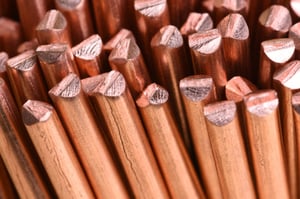 Over the past year or so, the manufacture of printed circuit boards (PCBs) has been one of the few constants in an electronic component market that's been beleaguered by lengthy lead-times, allocation challenges and capacity issues.
Over the past year or so, the manufacture of printed circuit boards (PCBs) has been one of the few constants in an electronic component market that's been beleaguered by lengthy lead-times, allocation challenges and capacity issues.
But now, just as the continuity of the supply chain is beginning to stabilise, and prices are slowly coming down, the rise of new technologies is putting the squeeze on availability of one of the most crucial materials in PCB production: copper laminate.
While a PCB normally equates to only around 0.5% to 2% of the overall value of an assembled product, it is a critical component at the heart of every assembly. So ensuring reliable and sustainable supply of its vital raw materials is a crucial factor.
The impact of new technologies
A report earlier this year from independent business news publisher Stockhead provided a stark view of the global copper shortfall when it reported that the world was running on a 1.3 copper consumption ratio - or just a 10-day supply of copper.
Global demand for copper meanwhile, has been on the rise. It's a trend that's being substantially influenced by the shift away from fossil fuel vehicles towards the vision of an "all-electric" automotive industry.
And as production of electric vehicles continues in earnest, it comes as no surprise that the demand for copper (used in the production of lithium batteries) is at an all time high.
The rapidly expanding global implementation of 5G is another contributing factor impacting copper supply, with each new 5G base station requiring large quantities of the high performance copper-clad laminate FR4, a product which has previously only been produced in lower volumes.
Further compounding the problem is the fact that many laminate manufacturers have shifted their attention to producing these higher performance (and higher margin) FR4 materials -with the production of standard FR4 laminate taking more of a back seat.
Key decisions at the PCB design stage
PCB lamination relies on the selection of suitable materials - and choosing the right laminate is a crucial step in ensuring the stability, lower loss and performance of the final assembly.
But while your design engineer's purchase order or fabrication drawing may highlight the material they believe needs to be used, it may be worth asking a few key questions early on in the design phase.
What is the real end application of their choice of material? What are the operating conditions? And, perhaps most crucially, are there alternatives that could do the job just as well?
One key piece of advice for design engineers is to avoid specifying a specific laminate material type or brand and to opt instead for one of the 55+ laminate materials that are currently contained within the industry standard IPC4101.
Clarification of copper weight is another core area, with electronics manufacturers being advised to scrutinise their PCB portfolio in terms of copper thickness and type of base material.
Quite often, customers will only specify the copper weight (for example 2oz) on their data, but will omit to advise whether this reflects the base or finished weight.
The discrepancy between the two can make a big difference - both to the cost and to the end application - so it is advisable to clearly state your requirements in microns and to indicate whether this is the base or finished thickness.
As the electronics manufacturing industry moves into 2020, the materials supply pipeline is anticipated to become increasingly unpredictable.
Component supply shortages, raw-metal supply challenges and the volatile international trade environment are all having an effect on customer purchasing levels, which in turn is impacting on the accuracy of forecasting.
While laminate suppliers are working hard to keep inventories steady, and are doing their best to smooth the flow, the reality is that their efforts can only work for so long.
But by rethinking raw material selection at the design stage, and by paying closer attention to the finer details such as the accuracy of copper weight specifications, engineers can help offset potential supply chain challenges early on in the PCB design process.

